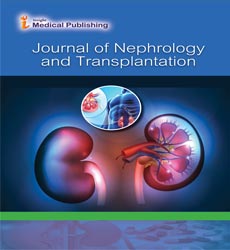Hyperparathyroidism in Failure of Chronic Renal
Erika Carneiro*
Department of Medical Science, Federal University of Santa Catarina, Florianópolis, Brazil
- *Corresponding Author:
- Erika Carneiro
Department of Medical Science,
Federal University of Santa Catarina, Florianópolis,
Brazil,
Tel: 5598988258973;
E-mail: erikacarneiro0204@gmail.com
Received: February 18, 2022, Manuscript No. IPNT-22-11349; Editor assigned: February 21, 2022, PreQC No. IPNT-22-11349 (PQ); Reviewed: March 07, 2022, QC No. IPNT-22-11349; Revised: March 11, 2022, Manuscript No. IPNT-22-11349 (R); Published: March 18, 2022, Invoice No. IPNT-22-11349
Citation: Carneiro E (2022) Hyperparathyroidism in Failure of Chronic Renal. J Nephrol Transplant Prod Vol:6 No:1
Commentary
In addition to this "classical" theory of hyperparathyroidism and the development of high-turnover bone diseases in chronic renal failure, a second theory has emerged in recent years. Suggests skeletal remodeling, i.e. H. Osteoblast function: decreased by chronic renal failure. Hyperparathyroidism would then be a physiological response to maintain normal bone turnover. However, since PTH only stimulates osteoblast progenitor cells, but not osteoblast differentiation, very high levels of PTH would be needed to enhance bone formation. The theory is supported by studies showing that prevention of hyperparathyroidism in chronic kidney failure leads to decreased bone remodeling. The cause of reduced osteoblast function appears to be Bone Morphogenetic Protein (BMP), which is reduced in chronic renal failure and, when replaced, leads to normalization of bone turnover. Interestingly, both the increased and decreased bone turnover normalized, which confirms that it is the maturation of the osteoblasts and not their proliferation that is affected.
An often underestimated factor in ROD is uremia-associated metabolic acidosis, which occurs when the GFR has dropped to around 40 ml/min. Since bone is an important protein buffer, the reduced pH stimulates the release of carbonate and phosphate. This is done in a bimodal way. First, the mineral dissolves, and then it is actively reabsorbed by osteoclasts. Furthermore, metabolic acidosis suppresses the osteogenic activity of osteoblasts and increases osteoclast activation.
To standardize the diagnosis of ROD, a new classification was recently proposed at the second controversies conference on the definition, evaluation, and classification of renal osteodystrophy to improve overall outcomes of kidney disease. 16 Here, ROD is classified according to turnover bone, mineralization and volume (TMV classification) which in turn are represented by selected acceptable histomorphometric parameters. For example, bone turnover can be characterized by the rate of bone formation, mineralization by volume of the osteoid, and bone volume by measuring the volume of bone in cancellous bone. Depending on the measurement, bone turnover and bone volume can be classified as low, normal, or high and mineralization as normal or abnormal. The results for each parameter can be used to accurately diagnose all three forms of kidney bone disease and osteomalacia.
The prerequisite for the diagnosis of ROD is the collection of an adequate bone sample. The bone biopsy should be performed with a trocard or a large bore drill. To calculate dynamic bone parameters, tetracyclines must be administered for several days, three weeks, and one week before sampling. Like calcium, tetracycline binds to the bone matrix and is therefore incorporated into bone. Each period of tetracycline ingestion creates a distinctive line that can be visualized by fluorescence microscopy. The rate of bone formation and other dynamic parameters can be calculated from the distance between the two tetracycline lines.
The most important serological markers for osteoclast activity are Tartrate-Resistant Acid Phosphatase (TRACP), telopeptides, and pyridinoline crosslinks. TRACP is produced by osteoclasts and various other organs. Its sensitivity and specificity for high turnover bone diseases that are similar to other markers. The telopeptide and pyridinoline crosslinks are cleared by the kidney and therefore increased in kidney failure. Both molecules are breakdown products of collagen and are produced during osteoclastic bone breakdown. The diagnostic value of telopeptide and pyridinoline cross-links is unknown, and these markers are used in the diagnosis and monitoring of osteoporosis rather than kidney bone disease.
In kidney patients with decreased bone mineral density, the diagnosis of the underlying bone disease is a prerequisite for treatment. Measuring bone density alone will not be sufficient, as all types of ROD are associated with a similar loss of bone density. Therefore, the decrease in bone mineral density, whether measured by dual-energy absorptiometry, quantitative computed tomography, ultrasound, or MRI, will not differentiate between the various etiologies.
In a small and yet unpublished pilot study with hemodialysis patients, a positive influence of recombinant PTH on bone density was observed. BMP7 has been shown to be effective in rodents, but human studies are still lacking. Bisphosphonates should be avoided due to their inhibition of bone turnover and the risk of worsening dynamics bone disease.
Open Access Journals
- Aquaculture & Veterinary Science
- Chemistry & Chemical Sciences
- Clinical Sciences
- Engineering
- General Science
- Genetics & Molecular Biology
- Health Care & Nursing
- Immunology & Microbiology
- Materials Science
- Mathematics & Physics
- Medical Sciences
- Neurology & Psychiatry
- Oncology & Cancer Science
- Pharmaceutical Sciences
